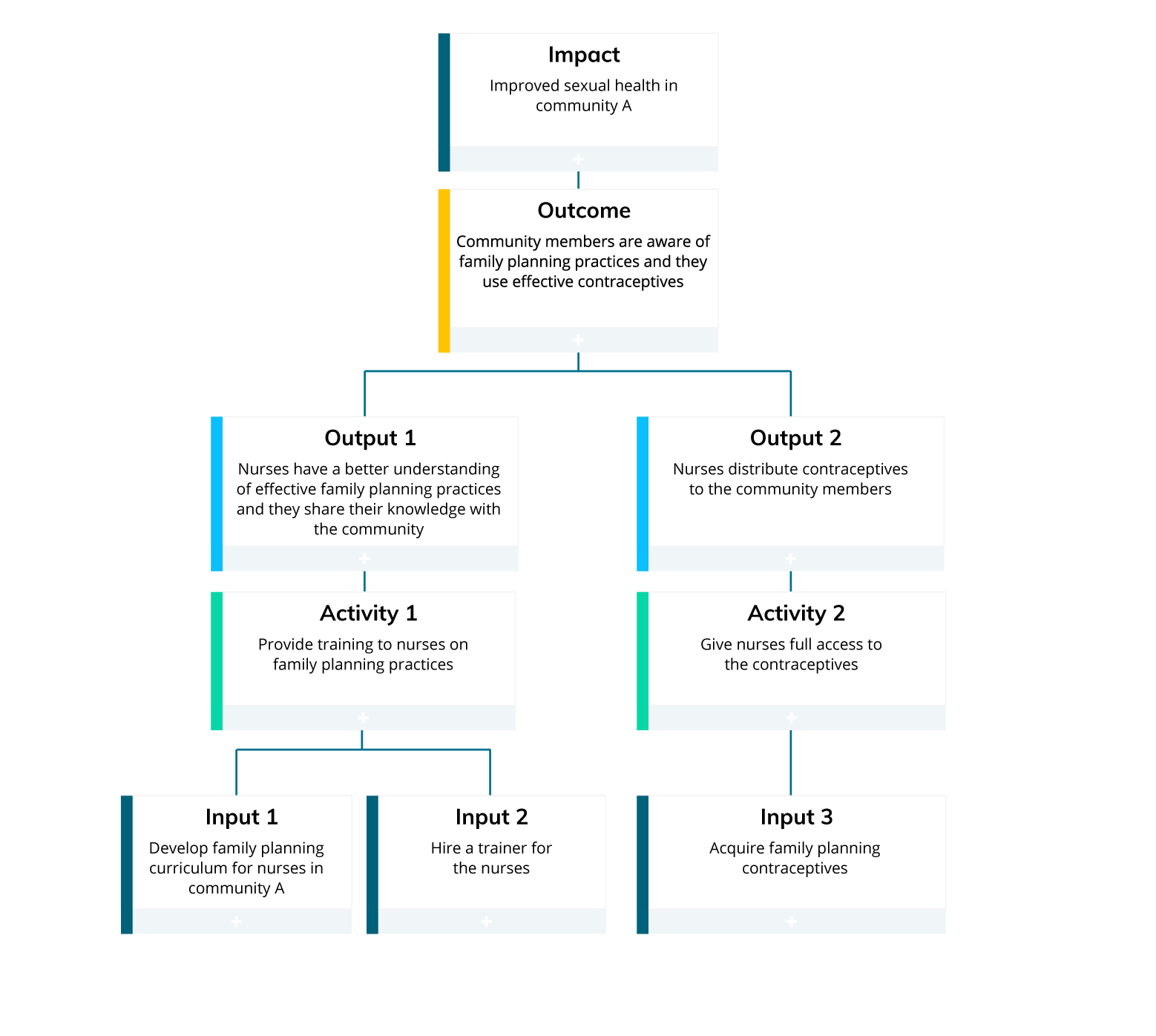Results framework: what is it and how to build one?
April 23, 2019
In this article, we deep dive into one of the most intrinsic elements of M&E – The Results Framework. Discover what a results framework is and why it is an important part of an M&E process. Using a simple example, the article demonstrates the distinction between different strategy levels of a project and its cause-and-effect relationship to shed light on the logic behind a results framework.
‘Monitoring and evaluation (M&E)’ is a powerful process that is integrated into the planning, action and reflection cycles of your project to transform its performance and enhance its impact. However, at times, the jargon and components of M&E could be quite confusing, even to the professionals inside the development realm. In this article, we will try to clarify one such integral element of M&E, called the ‘Results Framework.’
What is a results framework?
A results framework is a planning, communications and management tool that emphasises on results to provide clarity around your key project objectives. It was introduced in the mid-1990s by USAID as a new approach to monitor its programs throughout the agency. A good results framework is based on a good mix of logic, analysis, standard theories in the technical sector, and the expertise of on-the-ground managers.
The purpose of a results framework is similar to that of a log-frame or the theory of change. It helps practitioners to plan and understand the various facets of a project intervention and demonstrate it in a clear graphical manner. A results framework uses a chain of series to display project hypothesis, activities, processes and the intended changes that are expected to occur throughout the project cycle to achieve the project objectives. It leads to the identification of performance indicators at each stage in this chain, as well as risks which might impede the attainment of the objectives.
The elements of the chain of series are laid out under different levels and connected by a cause-and-effect relationship. In short, a person looking at a results framework would be able to understand the basic theory for how key project objectives will be achieved.
The naming of the results framework levels could vary, but most organisations use input, activity, output, outcome and impact.

Common terminologies that are used to represent the levels in a results framework.
Designing the results framework starts during project identification phase, but the design is improved and adapted throughout the project cycle. But before a team develops a full-fledged results framework, it is essential to have a shared understanding of the problem the project is intending to solve. It is also important to have a series of hypotheses of how the project inputs will lead to the desired outcomes, along with a knowledge of the type of evidence required to assess progress toward results.
Still confused? Let’s try to explore the concept a little further.
Understanding the cause-and-effect relationship
So, what is the cause-and-effect relationship among levels? In simple words, our project ‘input,’ which includes the initial resources we invest into our project in the form of money, staff, facilities or equipment, fosters our ‘activities.’ Activities, on the other hand, are actions that organisations undertake to deliver project goals.
Our actions or ‘activities’ would then trigger changes that results in our ‘outputs.’ So it means that ‘outputs’ are products and services that are delivered by our team as a result of our actions. Moving on to the next phase, we would expect our outputs to subsequently stimulate changes that results in our ‘outcome.’ Outcomes are modified behavior, conditions and situations of individuals, communities, businesses, or organisations that results from our project outputs. Depending on the nature of the intervention, outcomes can be short term, medium term or long term.
Lastly, the changes at our ‘outcome’ level would be expected to trigger our project ‘impact.’ Impact is a long term effect or behavioral change in a community (or even society) that our project attempts to create – this is our overarching project goal.
The key question to ask at every level is – “what result did our intervention in this particular level achieve?” It is a good idea to revisit each level frequently to make sure that our assumptions hold true and that it is logical and realistic for our strategy to be valid.
Let’s take a simple example
Let’s assume that our organisation has developed a project to implement in ‘Community A.’ Our overall project goal is to improve the sexual health of the community members. Let’s look at how we can lay out our objectives and intended results into different levels on a results framework.

The results framework displaying the cause-and-effect relationship among different levels of the Community A project.
If we take a closer look, we will notice that our project ‘inputs’ include developing family planning curriculum for nurses in Community A, hiring a good trainer and acquiring family planning contraceptives. Our project cannot begin until we take these first steps. Once we have a full-fledged curriculum, a good trainer and other required resources in place, we are ready for our next step, which is leveraging our resources to train the nurses on family planning practices and giving them access to effective contraceptives – this makes up our ‘activities.’ You may notice that both ‘inputs’ and ‘activities’ are under our control and their success depends on our efforts and performances.
Moving on to the next level, we assume that our ‘activities’ will result in our ‘outputs.’ In this case, our ‘output’ would be nurses having an improved knowledge on family planning practices and them sharing their knowledge with the community through good services. Another possible output could be nurses distributing contraceptives to the community members. This will subsequently bring us to our next assumption, where we expect community members to acquire a decent understanding of family planning practices through the trained nurses and that they start using the contraceptives they have received. If everything goes as planned, this outcome will lead us to our final impact, which is our overarching program goal – the overall sexual health of Community A will improve.
One important thing to remember is – a results framework must be current for it to be effective. Therefore, we should consider revising it when our results are not achieved within an expected time-frame, or when our critical assumptions are no longer valid. Likewise, it can also be updated when we notice that the underlying development theory or critical problems with policy, operations, or resources were not adequately recognised.
Another important point to keep in mind is – building a results framework alone is not enough to solve the problems that our project sets out to tackle. It is indispensable to measure our intervention at each level to track our real progress and to identify and analyse issues that are causing delays or unexpected results.
How do we measure progress at each level?
How do we know whether our activities have resulted in the intended outputs or our outputs have resulted in the intended outcome and so on? This is where well-defined performance indicators come into play. Indicators are vital to M&E, as these are the key for successful tracking of project changes or problems. Indicators allow program staff to measure up-to-date characteristics of the program’s success at each level and assess whether those results are in line with program targets and expectations.
To put it simply, in order to find out whether providing training to the nurses on family planning practices have resulted in our desired outputs, we can measure the changes by counting the number of nurses trained and how many of them performed well in their exams and so on – these are our indicators. Every level of our results framework has its own set of corresponding performance indicators.
We hope this article has provided some clarifications on questions surrounding the results framework. We welcome your thoughts on this topic.
Article by: Chandani Lopez Peralta, Content Marketing Manager at TolaData.




I am keen to learn more about monitoring and evaluation framework and how to become M&E specialist.
I am always keen to learn new concepts and ideas on M&E and want to become a specialist in this field.
A Very clear, simple and easy to follow example to use in any project.
Thank you
This is simple to understand. Looking forward to learning more about data Results Based Monitoring and Evaluation.
Results framework can also be referred to as results mapping and it’s actually a very interesting model for a critical assessment of projects/programs progress, or lack of it.
In case you need some help or guidance m&e field, I am an expert there
Yes! The results framework and mapping is an effective model of assessment. Thank you for your input!
Yes, I would love to hear more about this from you. I am looking to find ways of evaluating and monitoring projects and measuring its success/failure. Please email me if you are able to.
Thank you for the guidance by this article. It is clear and very helpful.
Thank you for your feedback! You can find more content like this on our blog: https://www.toladata.com/blog/
It was refreshing. Thank you.
Glad to hear that, Damodaram!
very insightful.
https://www.toladata.com/blog/build-a-results-framework/
https://www.toladata.com/blog/
Thank you for your feedback, Donald!
Excellent brief explanation of this nice topic. Very educative.
So glad to hear that, Elijah!
Well explained , I have gained something. Am doing research on Result Based M&E .
Thank you . Hope to gain more from you.
So glad to hear that, Sylvia! Please visit our blog section for new articles and resources on M&E —https://www.toladata.com/blog/
It is very clear and helpful. Thank you very much and hope to get such importance article more from you.
Thank you very much for your feedback, Songjukta! Please visit our blog section for more resources on M&E — https://www.toladata.com/blog/
Thank you for that explanation,hope to achieve more from you .
Thank you for your feedback, Okuta! Please visit our blog section for more resources on M&E — https://www.toladata.com/blog/
This is good enough to understand
This is good enough to understand. Need some more experimental example in this regard
Thank you for your feedback, Md. Ahasan Faruk. We will definitely try to incorporate more experimental examples into this piece.
Thank very much for very insightful explanations and easy to follow.
We are glad to hear that, Djax Sanga!
Hi Chandani,
Thank you for providing this information in a very simple way, it was very helpful and insightful.
Great article, easy to understand
Great knowledge gained
Thank you very much for this clear and easy to follow illustration